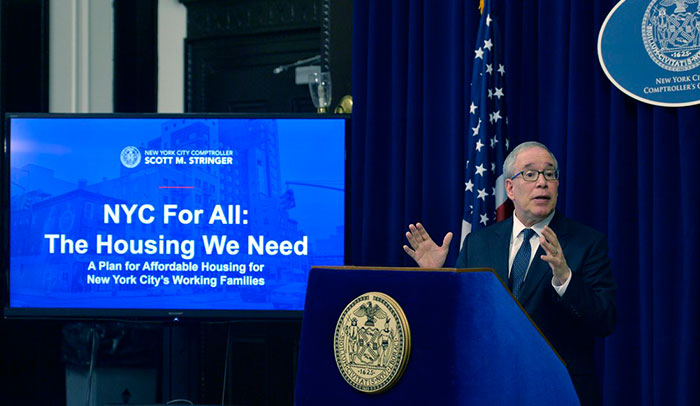Photo Courtesy of Comptroller Stringer’s Office
With “NYC for All: The Housing we Need,” Comptroller Stringer proposes a fundamental realignment of the City housing plan.
By Forum Staff
The City’s current affordable housing plan is not reaching those most at risk, according to a report released on Thursday by City Comptroller Scott Stringer that establishes the scope of Gotham’s affordable housing crisis and proposes a fundamental realignment of the program.
According to “NYC for All: The Housing We Need,” roughly 580,000 households across the five boroughs are in the greatest need of affordable housing. These households—almost 90 percent of which make less than $47,000 per year for a family of three—are paying more than half of their incomes to rent, bunking in overcrowded apartments, or have been living in homeless shelters for more than a year. Yet less than 25 percent of the City’s current affordable housing plan is being built for these New Yorkers, Stringer said.
The comptroller’s proposal connects the City’s housing policy to its rising homelessness crisis by tripling the homeless set-aside to 15 percent for new construction and planning to meet that goal each year. To finance the proposal, Stringer said he’s calling for the elimination of favorable tax treatment currently enjoyed by all-cash homebuyers and reducing “unfair, outdated” taxes on middle class New Yorkers who borrow to purchase a home.
According to “NYC for All,” the current affordable housing plan—Housing New York—is building nearly as many units for middle income families earning up to $155,000 per year as it is for extremely low income families earning less than $28,000 per year. Stringer said he is proposing to increase the number of units for the lowest income households and deepen subsidies for long term affordability.
Stringer on Thursday pointed out that developing housing for extremely low or very low-income households is more costly. So “NYC for All” calls for increasing the capital budget for new construction by $375 million annually, and repurposing the remaining 85,000 new units under the HNY plan for the households in the greatest need. And to safeguard the long-term viability of deeply affordable units, “NYC for All” proposes a new operating subsidy, funded at up to $125 million, to ensure that buildings have sufficient revenue to meet basic maintenance needs, while keeping rents affordable for the lowest-income households, the comptroller noted.
And in order to appropriately address rising rates of homelessness, the City’s approach to affordable housing must take into account working families that are at the greatest risk of becoming homeless, Stringer said. His report notes that of the families with children living in long-term shelter, one-third (nearly 4,500) are working—highlighting the fact that many working families struggle to find affordable housing.
Currently, HNY sets aside 5 percent of all units preserved and constructed for homeless New Yorkers—but just 1 percent of those units has gone to homeless families as of November 2017. Stringer’s report proposes tripling the number of newly-constructed units set aside for homeless families to 15 percent and meeting that target each and every year of the plan.
Additionally, “NYC for All,” calls for the elimination of the Mortgage Recording Tax in favor of a more progressive Real Property Transfer Tax.
Stringer’s proposal also calls for the creation of a Land Bank/Land Trust to help jumpstart the development of affordable housing on hundreds of vacant lots owned by the City.

